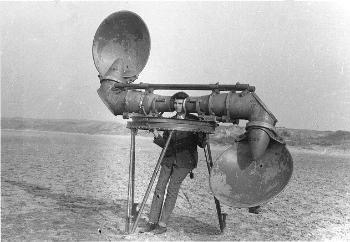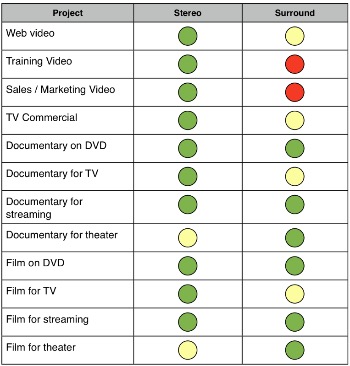
The quest to create a 3D visual experience has revved up, sputtered, and stalled for almost a century. But the journey for a 3D experience in sound has steadily evolved for more than eight decades. The early 1930's saw the first experimentation with stereo, and the first feature film to be released in stereo was Disney's Fantasia, in 1940. Ray Dolby introduced the revolutionary and practical Dolby Surround to movie theaters in the 1970's (4 channels: left-center-right-back). The movie-goer was now immersed in sound from several directions. But when they went home, they were limited to a cheap monaural $3 speaker in their television set.
In the 1980's, television stations began broadcasting in stereo, and by the 90's in surround (still only 4-channels). For the average consumer however, having surround sound in the home was costly and reserved for audiophiles. But the new millennium brought maturity of speaker designs that allowed big sound from small boxes. Digital broke down the analog barriers to permit 6, 7, 8 and even 11 channels of surround sound.
Now more than ever, surround sound is accessible to everyone. A show of hands for everybody out there that has surround sound in their homes. I would bet that most of you didn't have it twenty years ago. It's so prevalent today, that it only makes sense to take advantage of it.
One of our services at Dynamix is surround sound. Our control room is set up to mix and deliver up to 5.1 surround. Should you do your next project in surround? It depends on the project and the listener's environment. The chart below offers a quick comparison of suggested final audio formats:

Some notes on the chart above:
- Web video. If you're embedding a video on a web site, most users will view it on a desktop PC or mobile device. Very few PCs employ surround sound, so be sure you know your audience if you choose surround.
- Sales, training, and marketing videos. Most will be watched on a laptop, board room, or PC. See previous note.
- TV commercial. This surround option is evolving. Most network and local stations broadcast in surround, but not all. Most have the ability to downmix surround to stereo or mono. There are even some networks that are still in mono (egad!). You must poll each broadcast outlet for technical specs before sending your commercial.
- Documentaries and films. Most end listeners will have surround, or have a device that can downmix to stereo/mono. Use caution for television, as noted for TV commercials. In a theater, stereo can work on a surround system, but there is no guarantee. Some theaters, especially older ones, only have stereo systems. Like TV broadcast outlets, you must poll each theater.
Why would you want to mix in surround? The most obvious reason is to put the listener in a realistic environment. For films and documentaries (and to some extent, commercials), ambient and environmental sounds that match the story or visuals transport the viewer/listener into the narrative. Having a sound effect as a character, such as a helicopter flying 360-degrees around the room puts the viewer/listener in the middle of the action.
There are also subtle uses of all the channels to create depth, such as placing some of the music in the rear channels. If the music was produced in surround, then it's a bonus. Another use is for reverberation and effects on character voices if done with thought. The center channel is there so that the dialog is clear. But let's say the situation calls for the character to be in a warehouse. Having all the reverb just in the center channel may seem boxed up. Putting it in all the speakers opens up the mix and makes the warehouse bigger.
The last frequent use of surround is to match the listener's expectations. Let's say your TV spot is playing on a national broadcast, but mixed in stereo. If it follows a kick butt spot in 5.1 surround, it will seem a little flat in comparison. The same goes for a film or documentary that's being heard on a system that routinely plays surround sound. This argument can flow over into many other arguments we make about having a carefully constructed soundtrack. With so much media available today, the bar is continually pushed higher and higher on what the listener expects. Bad audio is bad audio. But great audio is the norm.
Dynamix Tech Notes
So what do all those surround sound numbers and letters mean? And what the heck is a "point-one"? Let's start with the simplest first. The original Dolby Surround was 4 channels, or as expressed today, "4.0". That was (L) Left, (C) Center (for dialog only), (R) Right, and (S) Surround, sometimes called LCRS. The surround channel is mono and was usually placed on the sides and back of theater walls.
Then came 5.1. That's actually 6 channels. (L) Left, (C) Center, (R) Right, (Ls) Left Surround, (Rs) Right Surround, and (LFE) Low Frequency Effect. The LFE channel is the "point-one" in 5.1. This mysterious one-tenth of a channel is really reserved for those extremely low sounds that the main system can't produce on its own. Thunder, explosions, and earthquakes are good candidates for LFE effects that need to be really loud in the bass range. It is NOT a catch-all subwoofer channel. In a theater (or excellent home theater) the LFE channel has a dedicated subwoofer, and the rest of the program has one or more subwoofers. In typical home theater systems though, one subwoofer does double duty by provided extremely low bass for the overall program, plus a feed of the LFE channel. You never fully experience the intended effect of the LFE in a typical home theater because of the power requirements. In a movie theater, the LFE speaker can be driven by an amplifier that's hundreds to thousands of watts. Plus, the LFE channel is usually used only in action or scifi movies, and then only sparsely.
7.1, 10.1, etc. are just more speakers added in different configurations. Each one has specific speaker placement requirements to fully experience the surround effect. So, if you already have a 5.1 system and want to move up to a 7.1 system, you just can't plug in 2 more speakers and put them anywhere they fit. You must re-locate all the main field speakers according to the given surround format, otherwise you will have holes in the sound field.
Today's common surround sound experience is one-dimensional. Think of what I've described as sitting in the middle of a flat wheel turned on its side like a roulette wheel. All the sound comes from one plane and from the edges. The next big thing in surround sound adds another dimension - height. Future systems will routinely push sounds from above, below, or completely around the listener. But that's another discussion.





